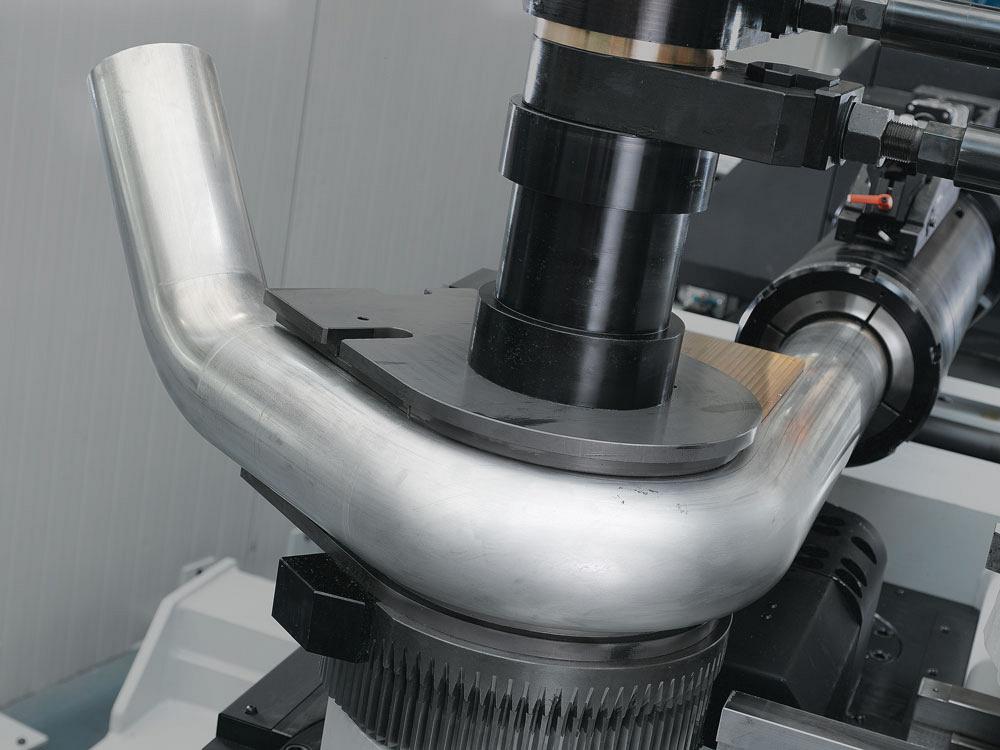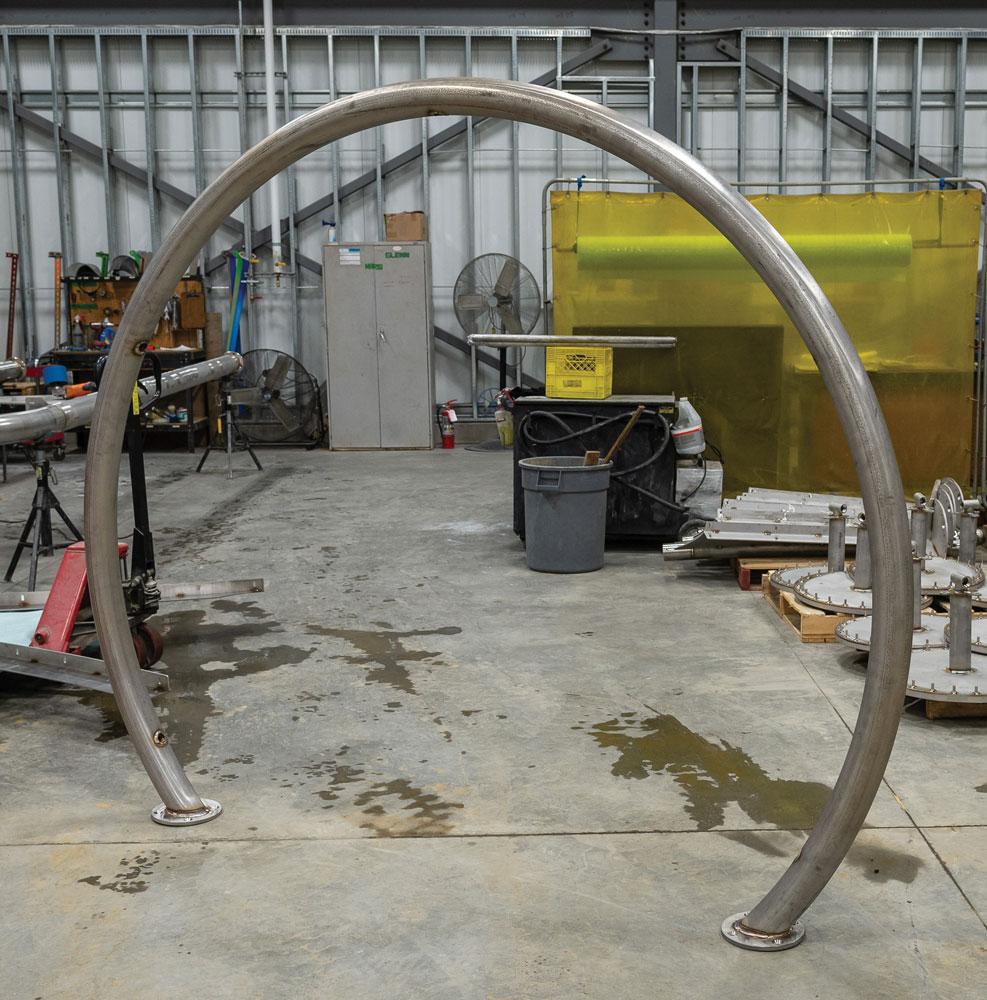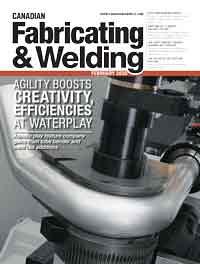Editor
- FMA
- The Fabricator
- FABTECH
- Canadian Metalworking
Tube bender, weld cell build efficiencies at Waterplay
Kelowna, B.C., aquatic play feature company gains from tube bender and weld cell additions
- By Rob Colman
- February 12, 2020
- Article
- Automation and Software

Waterplay’s BLM GROUP ELECT 150 all-electric tube bender can bend pipe of up to 6 in. diameter. The company has worked hard to standardize the material it uses, so most of the stainless steel pipe it bends is 3 in. diameter, Schedule 10. Image courtesy of BLM GROUP.
Living and working in a place like the Okanagan Valley comes with positives and negatives. For anyone who enjoys great wine and the outdoors, it can’t be beat. But for a fabricator, it can mean challenges sourcing materials and staff.
Waterplay Group of Companies manages to maintain a steady team on its Kelowna, B.C., shop floor, but lead times on formed pipe led to its recent investment in a tube bender. Other investments in time and labour-saving equipment and training, meanwhile, are some of the ways it’s working to keep its staff engaged and busy. Each investment is making the company more agile, creating opportunities for the Waterplay team to be even more creative in their product designs.
In-House Control
Waterplay, a designer and manufacturer of aquatic play features, has installations of its products in about 85 countries. The founders were inspired to start the business after seeing the UFO H2O fountain exhibit at the Expo ’86 World Fair in Vancouver. The company’s very first water park was installed in Whistler, B.C., in 1987 and remains in operation to this day.
Initially all manufacturing was outsourced, but when Jill White purchased the company 15 years ago, she gradually started bringing the metal fabrication of activity towers, urban features, and water management systems in-house. This allows the company to be more flexible in terms of making design changes on-the-fly. It also encourages discipline around material choices.
Dennis Scott, director of operations and engineering, joined the Waterplay team with the change in management. He now has a team of around 40 people in the fabrication shop. The team includes fabricating machine operators, welders, machinists, and polishers.
“About 95 per cent of the work we do is stainless steel, but there is also a bit of aluminum sheet work,” said Scott. “The plastics and acrylics we use in our parks are still outsourced. We’ve worked hard to standardize the material we use, so most of the stainless steel pipe we use is 3 in. diameter, Schedule 10. This size allows us the flexibility we need for some of our more outlandish creations while still being economical. Plate we use runs anywhere from 1/8 in. to ½ in.”
The company has been growing steadily for a number of years. Most recently it added 17,000 sq. ft. of manufacturing space to its facility.
Creative Flexibility
One of the new additions to the expanded facility is a BLM GROUP ELECT 150 all-electric tube bender, which can bend pipe of up to 6 in. diameter.

This photo of Cedric Archer Park in Rockhampton, Australia, provides good examples of the fanciful features fabricated at Waterplay’s Kelowna, B.C., facility.
Previously all tube bending was outsourced to shops in either Calgary or Vancouver, which presented challenges for the Waterplay team.
“The quality we got was always good, but for a simple design like a hoop it would be two weeks between me putting in a PO and receiving the part,” said Scott. “Now that’s down to two minutes. The other thing is, we’re a high-mix/low-volume shop, so the orders we were sending our vendors weren’t really ideal for them either. We just didn’t have the sort of volume they needed.”
If you look at Waterplay’s designs, you’ll see many tubular constructions spraying water and/or supporting other design elements, so it’s not a small part of what the team does. Having the machine in-house creates design flexibility that could never be fully realized without having a machine to make these shapes, and team members who fully understand its capabilities.
The machine can bend multiple radii using stack tooling. Operators can choose the tube bending direction they use the most, set the machine for right-hand or left-hand bending, and change the configuration if required. Up to eight tools can be fitted at the same time. Variable-radius tools can be used in any position.
“Bending pipe is still a bit of a black art, but with this all-electric bender we’re finding that once we put the parameters in, we get the consistency time and again,” said Scott. “If we ask for a 30-in. radius and we dial it in with the right parameters, we’re going to get that every time. There’s also the machine’s ability to learn, in a way. There are a lot of factors that go into tube bending. For instance, heat treatment of your pipe can be a big factor in the amount of springback you experience. We’re able to load up different categories of heat treatment for the tube bending and it calculates the springback. We’ve had all sorts of different batches of pipe come through the shop and we’ve tweaked it just a little bit based on theoretical heat treatment, and parts are coming out over and over right on the mark.”
Scott pointed to shared values as one of the reasons the team went with a BLM GROUP machine. “Waterplay owner Jill White really focuses on core values,” he said. “We strive for quality, and we saw similarities in our beliefs. It was a good match in that sense.”
But quality and consistency are still the major priorities. Scott compared the all-electric tube bender with hydraulic systems and considered the all-electric system just that much more precise. He and his team also found the software intuitive to use.
Waterplay’s machine includes an extension that allows the shop to work 20-ft. lengths of pipe with sufficient force to maintain accuracy. The machine was installed in October 2019.
“We are still learning more every time we use the machine, but we were up and running on it fairly promptly when it arrived in the shop,” said Scott. “The VGP3D software takes a lot of the guesswork out of it for you.”
Although the machine was purchased for Waterplay’s production work, Scott noted that it automatically creates a potential secondary market for anyone requiring tube work in the Okanagan Valley.
Removing the Repetitive
While the tube bender allows Waterplay to extend its creativity with forms, there has also been a drive to standardize certain stock products to streamline fabrication and create opportunities for welding automation. The company has invested in a two-bay Miller PerformArc 1100 FW robotic welding cell to do this work.
“There are certain big sellers like ground sprays, which are essentially a short piece of pipe on a base plate,” said Scott. “We make thousands of those. We also make a lot of water blasters or cannons, which can be made in batches of 100. We are working to move repetitive, less interesting jobs into the weld cell.”
The cell is equipped to weld up to 10-ft.-long columns. It includes a rotating indexing table so that one side of the cell can be loaded with parts as the other completes parts.
“This cell is also newly installed in the shop, and we’ve been told that it can increase our productivity exponentially,” said Scott. “We’re still working out some of the kinks, but already we’re cutting production time of certain parts by about 50 per cent.
“Adding this automation helps us in a couple of ways,” Scott continued. “It takes away a lot of dull work from our employees, freeing them up for more complex, interesting welding work. But also it saves us from carrying a lot of inventory. Our business is still fairly seasonal because the water park market is strongest in North America (though it’s growing in Australia). With automation we can turn orders around more quickly when we need them rather than carrying stock through our slower seasons. It makes us more agile. We aren’t working in a just-in-time environment, but we’re closer to that ideal.”
Agility Training
Waterplay is preparing for the future by creating agility among its team members as well. Scott is in the process of cross-training operators so that they can handle the tube bender, the welding cell, and the shop’s waterjet machine.
“We are also introducing bar coding to get more accurate timing on our assemblies through our ERP system,” said Scott. “And, of course, we’re considering how else we might improve production flow.”
What Scott is aiming for is production that keeps the full team busy and steady throughout the year – stability that can be a challenge in a market that is defined by specific peak production times.
“We’ve already realized tremendous gains with our recent investments,” said Scott. “Each step we make in the automation and interconnection of our manufacturing processes frees up more time for strategic thinking around how to expand future production.”
Editor Robert Colman can be reached at rcolman@canadianfabweld.com.
Waterplay Group of Companies, www.wmimfg.com
About the Author

Rob Colman
1154 Warden Avenue
Toronto, M1R 0A1 Canada
905-235-0471
Robert Colman has worked as a writer and editor for more than 25 years, covering the needs of a variety of trades. He has been dedicated to the metalworking industry for the past 13 years, serving as editor for Metalworking Production & Purchasing (MP&P) and, since January 2016, the editor of Canadian Fabricating & Welding. He graduated with a B.A. degree from McGill University and a Master’s degree from UBC.
subscribe now


Keep up to date with the latest news, events, and technology for all things metal from our pair of monthly magazines written specifically for Canadian manufacturers!
Start Your Free Subscription- Industry Events
Automate 2024
- May 6 - 9, 2024
- Chicago, IL
ANCA Open House
- May 7 - 8, 2024
- Wixom, MI
17th annual Joint Open House
- May 8 - 9, 2024
- Oakville and Mississauga, ON Canada
MME Saskatoon
- May 28, 2024
- Saskatoon, SK Canada
CME's Health & Safety Symposium for Manufacturers
- May 29, 2024
- Mississauga, ON Canada























